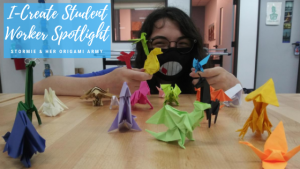“Hi, mamá,” are the first words Isabelle, my daughter, utters every evening when I pick her up from daycare. At two-years-old, Isabelle’s speech is developing, and her vocabulary is expanding. Her vocabulary consists of a balanced amount of both Spanish and English words. She is able to point at a “carro,” but she can also spot a “bus.” When Isabelle was born, my husband and I decided that we would only speak Spanish to her. We wanted her to master Spanish first. We figured that eventually, she would pick up English in school. But, of course, life happens, and plans change. Now, we are raising a bilingual toddler.
My mother was Isabelle’s caregiver until she was six-months-old, and under her care, Isabelle was only exposed to Spanish. She listened to my mother’s Los Temerarios jams, and she would hear her hour-long conversations with my aunts in Michoacan, Mexico. Since birth, she started absorbing Spanish–my native language. I learned to read, write, and speak Spanish by the age of six-years-old. My parents taught me the only language they knew. They learned English out of necessity; my husband and I are raising Isabelle to be bilingual because we want her to embrace our culture and reap the benefits of being bilingual.
I mentioned earlier that our plan was to raise Isabelle in a Spanish-only household, but when we relocated from Georgia, we didn’t know anyone. Our only option was to put Isabelle in daycare. I felt very anxious. I feared that Isabelle would forget what we taught her at home. We read to her, spoke to her, and sang to her only in Spanish for the first year and a half of her life, Spanish was all she knew. I expressed my fear to one of Isabelle’s daycare managers, and she allowed me to note down a few Spanish words that Isabelle used. In the beginning, Isabelle’s teachers used them with her, but they slowly stopped. Within a week, Isabelle said her first English word—shoes. When we heard her say it, my husband and I looked at each other. We both knew the transition had started. And honestly, the transition was harder for me than it was for Isabelle. I have come to the realization that knowing two or more words for an object or idea will expand rather than contract her mind (Baker, 2007).
Studies continue to show that bilingual children are at an advantage. One advantage is that bilingual children learn to use interpersonal association before monolinguals (Byrd, 2012). They can also develop problem solving skills faster than their peers. Bilingual children learn early on that if they match the correct language with their conversational partner, they will get positive results. If they speak Spanish to someone who does not, their outcome will not be positive (Byrd, 2012). Personally, I have witnessed this scenario with my bilingual nieces and nephews. They speak to me in English, but they know that if they want my mother to bake her delicious empanadas, they have to ask her in Spanish.
Another advantage is that studies have shown that pre-school age bilingual children have better control over their attention and inhibition than their monolingual peers (Byrd, 2012). In one task, three-year-old monolingual children were asked to sort several cards first based on color. For the second task, they were asked to sort the cards based on shapes. The monolingual children were able to follow the first task successfully; but instead of sorting the cards based on shapes, as instructed, monolinguals continued sorting the cards based on colors. Older monolinguals, who were about five-years-old, were able to successfully follow both tasks. Three-year-old bilingual children were able to successfully follow both sets of instructions. The results concluded that the bilingual children outperformed the monolingual children at a younger age (Byrd, 2012).
When I hear my daughter chant the “Itsy Bitsy Spider” in both English and Spanish, I feel so proud and encouraged. What we are doing is working! And I am ecstatic because being bilingual is a lifelong advantage. I perceive bilingualism as a gift that I can pass on to my child, and hopefully she will be able to pass on that gift to her children too. If you are thinking about raising a bilingual child, I would say consistency and repetition are key. Before my daughter was born, I spoke Spanish occasionally, mainly with my parents. Isabelle is helping me redevelop my Spanish-speaking skills, and I am speaking it more than I have in a long time. We are traveling to Mexico soon, and she will have the opportunity to meet my extended family and immerse herself in our culture. She will also get to use her Spanish-speaking skills–I am looking forward to that!
To read more about the subject, check out the following:
Articles:
Hearing Bilingual: How Babies Sort Out Language
https://archive.nytimes.com/www.nytimes.com/2011/10/11/health/views/11klass.html
Why Bilinguals Are Smarter
https://www.nytimes.com/2012/03/18/opinion/sunday/the-benefits-of-bilingualism.html
Books:
A Parents‘ and Teachers‘ Guideto Bilingualism
Baker, Colin
P115 .B346 2007
Bilingual: Life and Reality
Grosjean, Francois
P115 .G75 2010
References:
Baker, C. (2007). A Parents’ and Teachers Guide to Bilingualism. Buffalo, NY: Multilingual Matters LTD
Byrd, D. (2012). Cognitive Benefits of Being Bilingual. Journal of the Washington Academy of Sciences, 98(3), 19-30. Retrieved from http://www.jstor.org/stable/24536482


